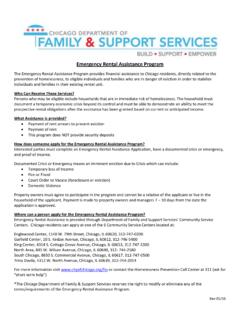Transcription of CHAPTER 7: TENANT-BASED RENTAL ASSISTANCE
1 CHAPTER 7: TENANT-BASED RENTAL ASSISTANCE HOME permits participating jurisdictions (PJs) to create flexible programs that provide ASSISTANCE to individual households to enable them to rent market-rate units. These programs are known as TENANT-BASED RENTAL ASSISTANCE , or TBRA. This CHAPTER highlights eligible TBRA households and units, eligible types and levels of subsidy, options for establishing a TBRA program, and key issues for design and administration of a TBRA program. NOTES PART I: HOME PROGRAM REQUIREMENTS WHAT IS TENANT-BASED RENTAL ASSISTANCE ? TENANT-BASED RENTAL ASSISTANCE (TBRA) is a RENTAL subsidy that PJs can use to help individual households afford housing costs such as rent and security deposits.
2 PJs may also assist tenants with utility deposits but only when HOME is also used for RENTAL ASSISTANCE or security deposits. Types: There are many types of TBRA programs. The most common type provides payments to make up the difference between the amount a household can afford to pay for housing and local rent standards. 9 The Section 8 Voucher Program is an example of a typical TBRA program. Other TBRA programs help tenants pay for costs associated with their housing, such as security and utility deposits. (However, under the HOME Program, utility deposit ASSISTANCE can only be provided in conjunction with RENTAL ASSISTANCE programs or security deposit programs.) How TBRA differs: HOME TBRA programs differ from other types of HOME RENTAL housing activities in three key ways: Building HOME Page 7-1 Department of Housing and Urban Development March 2008 CHAPTER 7: TENANT-BASED RENTAL ASSISTANCE NOTES TBRA programs help individual households (rather than subsidizing particular RENTAL projects).
3 TBRA ASSISTANCE moves with the tenant -- if the household no longer wishes to rent a particular unit, the household may take its TBRA and move to another RENTAL property. The level of TBRA subsidy varies -- the level of subsidy is based upon the income of the household, the particular unit the household selects, and the PJ s rent standard (rather than being tied to the PJ s high and low HOME rents). WHY CREATE A TBRA PROGRAM? PJs have developed TBRA programs for a wide variety of reasons to serve a wide range of functions. Some of the most common advantages of establishing a TBRA program are noted below. Flexibility for Households TBRA programs offer a household the opportunity to choose its neighborhood (including the school district) as well as its type of housing (such as a single-family home, large apartment building, duplex, garden-style unit, etc.)
4 If the household needs to change location, the household may take the TBRA ASSISTANCE along when it moves to another RENTAL unit. At the discretion of the PJ, the TBRA may be used outside of the PJ s jurisdiction. Flexibility for PJs TBRA programs offer jurisdictions a way to meet fluctuating demand for housing. A PJ may elect to provide TBRA ASSISTANCE to as many or as few households as it chooses, subject to its HOME budget and consistent with its Consolidated Plan. Also, PJs may design specialized TBRA programs tailored to the distinctive housing needs of the community. This includes programs designed specifically for persons with special needs. Building HOME Page 7-2 Department of Housing and Urban Development March 2008 CHAPTER 7: TENANT-BASED RENTAL ASSISTANCE NOTES Cost-Effectiveness In communities where large public subsidies are needed to spur the new construction or rehabilitation of units, TBRA may be less expensive than using HOME for rehabilitation or new construction.
5 TBRA may be particularly effective in communities with high vacancy rates, where the PJ wants to make units affordable, but does not want to finance the development of additional units. Risk Avoidance Financing the construction or rehabilitation of housing is inherently risky. Owners and developers can (and sometimes do) default on their financing, sending projects into foreclosure and putting at risk the PJ s investment. Since TBRA programs are TENANT-BASED , the PJ can terminate the ASSISTANCE if the tenant fails to meet program requirements. TBRA poses no long-term financial obligation to the PJ. One Exception: Relocation ASSISTANCE PJs are not allowed to require households who receive TBRA as relocation ASSISTANCE to participate in self-sufficiency and Displacement ASSISTANCE PJs may use TBRA to assist households displaced by HOME projects, facilitating the rehabilitation of occupied units.
6 ELIGIBLE ACTIVITIES RENTAL ASSISTANCE Programs The HOME rules are flexible regarding the types of TBRA programs that may be developed by PJs. HOME TBRA programs may be designed to serve the general objective of making housing more affordable for a wide range of low-income households within the jurisdiction. PJs may want to create a TBRA program that serves the entire community in response to a high level of rent burden and/or a long Section 8 waiting list. Building HOME Page 7-3 Department of Housing and Urban Development March 2008 CHAPTER 7: TENANT-BASED RENTAL ASSISTANCE NOTES Alternately, TBRA programs may focus on a special purpose or specific housing need. Options for special purpose programs are also described below.
7 Self-sufficiency programs: PJs may require HOME TBRA recipients to participate in self-sufficiency programs as a condition of RENTAL ASSISTANCE . For example, the PJ may operate a bootstrap program that provides TBRA to low-income persons who are attending job training. Homebuyer programs: HOME TBRA may assist a tenant who has been identified as a potential low-income homebuyer under a lease-purchase program. The PJ may provide HOME TBRA to these homebuyers until the purchase is completed. The HOME TBRA payment must be used for monthly RENTAL and/or utility expenses. This means that HOME-funded TBRA may not be used to create equity in the unit on behalf of the homebuyer. However, all or a portion of payments made by the homebuyer may be used to build such equity.
8 When the homebuyer is ready to purchase the unit, HOME funds may also be used for downpayment ASSISTANCE . Targeted populations programs: The PJ may establish local preferences for special-needs groups within its broad, community-wide program, or it may design a specific program that exclusively serves one or more special needs groups. Examples of such special needs groups may include: 9 Homeless persons; 9 Persons with disabilities; or 9 Persons with AIDS. If TBRA is provided exclusively to persons with a particular type of special need, the need must be identified in the PJs Consolidated Plan as an unmet need and the preference must be needed to fill the gap in benefits and services available to such persons.
9 Building HOME Page 7-4 Department of Housing and Urban Development March 2008 CHAPTER 7: TENANT-BASED RENTAL ASSISTANCE NOTES Tenants Avoiding Displacement Tenants who receive HOME TBRA to avoid displacement from a HOME-funded project may remain in the project or move to another suitable unit, taking the TBRA with them. displacement Anti- ASSISTANCE programs: TBRA may be used to minimize displacement associated with HOME-funded activities. Security Deposit Programs The PJ may establish a program that limits ASSISTANCE to help tenants with security deposits. The term security deposit is defined by the local or state tenant-landlord law covering the jurisdiction. The maximum amount of HOME funds that may be provided for the security deposit is the equivalent of two months rent for the unit.
10 Only the tenant (not the landlord) may apply for security deposit ASSISTANCE . The lease between the landlord and tenant may not contain certain prohibited lease provisions (see Lease Requirements later in this CHAPTER ) and must be in effect for at least one year. The security deposit may be paid to the tenant or directly to the landlord. The security deposit may be made as a grant or a loan. If the deposit is a loan, the terms of that loan, including provisions for repayment, should be set out in a written agreement between the PJ and the tenant. Ineligible Program Activities Despite the flexibility the HOME Program provides for TBRA, there are a number of program activities that are ineligible for HOME TBRA ASSISTANCE .














